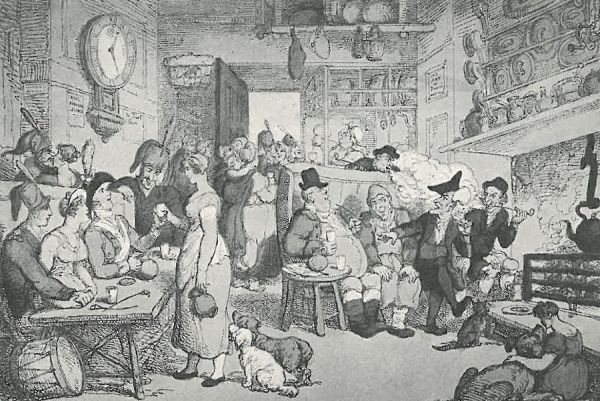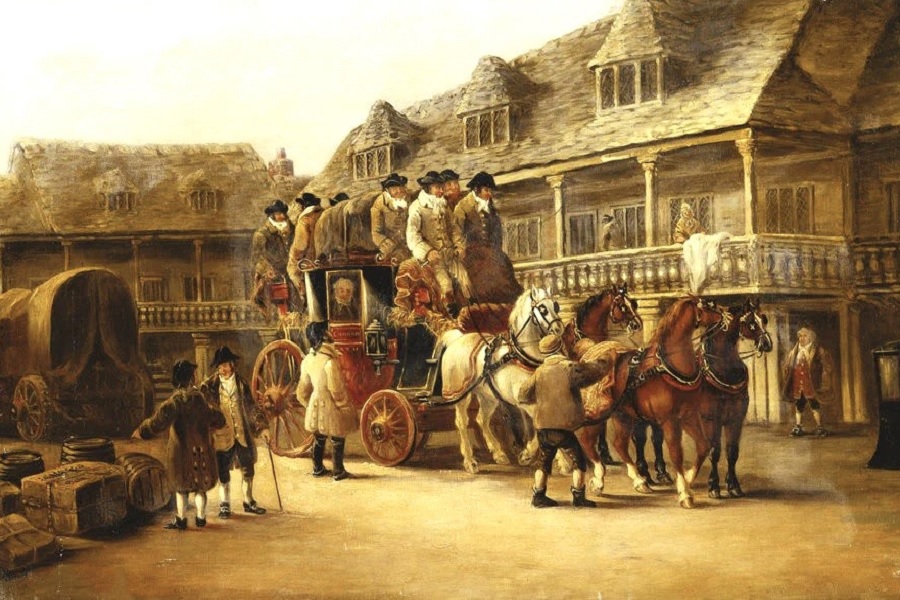Coaching Inns and the Great North Road
As stage-coaches and wagons multiplied during the 18th and early 19th centuries, they spawned a new network of inns and support facilities. Passengers, coachmen and servants all needed food and lodgings. Horses needed rest, hay and water.
There were literally hundreds of coaching inns along the route of the Great North Road. We cannot do justice to them all but some of the more famous or interesting ones get a mention.
About Coaching Inns
Since the Roman mansios, there have been many types of hostelries catering for travellers including those on horseback – so what is a “coaching inn”? The answer is not hard and fast but certain characteristics are indicative:
- An enclosed courtyard behind the inn which included extensive stabling
- A gated archway through to the yard for coach traffic
- Galleried (“deck access”) construction
- A “gallows inn sign” spanning the road (rather than the usual projecting sign)
- Designaton as a post house (with the innkeeper doubling as postmaster)
- Historical record associating the inn with specific coaching services
- A name and reputation known beyond its local area
- Operational during the coaching boom of the late 18th and early 19th centuries
Coaching inns generated their own folklore. Landlords cultivated tales of royal visitors and historic events to enhance their inns’ reputations. Coachmen told stories of highwaymen, scandal and supernatural events to maximise their gratuities. Travellers, including a new breed of travel writers, passed on their own tales and experiences. Novelists, including Dickens, increasingly featured coaching inns in their fiction.
By the time the coaches were giving way to rail in the 19th century there was real nostalgia for a lost way of life. Perhaps as steam railways gave way to diesel and electric 100 years later, people forgot about the former trials and tribulations and with misty eyes remembered a warm, more intimate and characterful golden age.
Our Great North Road historian, Charles Harper, wrote a book about the “Old Inns of Old England” in 1906:
“This is one of the last surviving joys of travel in these strange times when you journey from great towns for sake of change and find at every resort that the town has come down before you, in the shape of an hotel more or less palatial, wherein you are expected to dine largely off polished marble surroundings and Turkey carpets, and where every trace of local colour is effaced. A barrier is raised there between yourself and the place. You are in it, but not of it or among it; but something alien………
At the old-fashioned inn, on the other hand, the whole establishment is eloquent of the place, and while you certainly get less show and glitter, you do, at any rate, find real comfort, and early realise that you have found that change for which you have come.”
This coaching inn legacy carried forward into the 20th century. Many inns succumbed to a loss of trade and were re-purposed or gave way to development but those that survived received a new boost once the car again increased road traffic. It was only in the 1930s that a new breed of car friendly, modern hotels such as “Knights of the Road” started to change the rules.

A late 18th century coaching inn kitchen – Thomas Rowlandson
More Information About Coaching Inns
The Old Inns of Old England, Harper, 1906
Historic Coaching Inns of the Great North Road, Roger Protz, CAMRA, 2017

